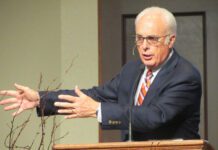Pick up New Ideas
By listening to others preach, we can pick up exegetical insights, personal illustrations and ways of applying a text that may never have occurred to us personally. No two preachers’ bookshelves house the same books. No two preachers’ lives experience the same events in the same ways. No two congregations need to hear the same text applied in exactly the same way.
If we depend solely on our own books, experiences and perceptions of what people need, our preaching will become stale and predictable very quickly.
Find a Guest Speaker
How often have you been moved by another preacher’s words, only to find them powerless when you attempted to relay them to your own congregation? There was something more to what the preacher said than the words alone. It was something in the way they were said. There was a power, a depth of conviction, a rare flash of raw sincerity that could not be captured. If that sermon was recorded, why not play it for your people? You need not abdicate your pulpit for the whole sermon necessarily. Edit the clip to what you found to be the most poignant.
Pastors used to have to spend hundreds or thousands of dollars to bring in guest speakers. Some speakers they never could afford; others they felt too ashamed to ask to visit their small congregations. YouTube costs nothing, and the preachers there never will gossip about anything in your church.
Hear the Author
It’s one thing to read what a writer says about how to construct a sermon. It’s another to hear him preach. Some homileticians write far better than they preach, and some preach far better than they write.
I think all of us who attempt to write about preaching naturally use our best sermons as examples of the concepts we’re describing. We also try to provide the purest examples of those concepts. The problem is that none of us are at our best every Sunday, and rarely are our sermons purely topical, textual or expository. In any given message, we may violate as many of our homiletical principles as we keep. Nevertheless, regular patterns emerge, and principles manifest in practice.
When we come across a book on the theory or methods of preaching, we ought to look for video examples of the author in practice. The more examples, the better we can gage how well his or her theory and methods actually work and help us to know if we want to follow suit.
Study Good (and Bad) Examples
Closely related to the last point yet distinct is the way YouTube yields good examples for preachers to dissect. Many excellent preachers never take the time to write down their methods. They may be embarrassed by trying to explain what they do so naturally without thought. Like the oral prophets Elijah and Elisha, they remain worthy of study despite their inability to commit their procedures to the printed page.
Yankees great Yogi Berra reportedly said, “You can observe a lot by watching.” The late Adrian Rogers would have agreed. When I once asked him to identify the five books that most influenced how he preached, he could think of only one book he had read on the subject. It was a title by Andrew Blackwood that was required reading while he was in college. “Most of what I know about preaching,” Rogers told me, “I learned from observation and experience.”











